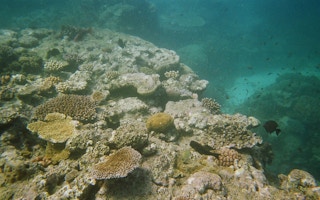Prior to the back-to-back bleaching events that hit the Great Barrier Reef in 2016 and 2017, the UNESCO World Heritage Site had suffered two other bouts of extensive bleaching in the past two decades, one in 1998 and another in 2002.
The damage done to the Great Barrier Reef by those bleaching events was worrying enough for scientists, and now new research finds that in the intervening years the reef system recovered at a much slower rate than it has in the past. According to a study published in the journal Science Advances this month, the Great Barrier Reef is losing its ability to bounce back from disturbances like coral bleaching, crown of thorns starfish outbreaks, and cyclones.
This impaired recovery ability is likely due to the succession of acute disturbances the reef has experienced as well as the ongoing impacts of chronic pressures like poor water quality and climate change, researchers found. But the study’s authors also say that effective local management strategies could help restore the reef’s capacity to recover.
A team of researchers led by scientists at Australia’s University of Queensland (UQ) found that, during the 18-year period between 1992 to 2010, the coral recovery rate of reefs in the Great Barrier Reef Marine Park declined by an average of 84 per cent.
“This is the first time a decline in recovery rate of this magnitude has been identified in coral reefs,” the study’s lead author, Juan Ortiz of The Australian Institute of Marine Sciences and UQ’s School of Biological Sciences, said in a statement. “The future of the Great Barrier Reef is threatened without further local management to reduce chronic disturbances and support recovery, and strong global action to limit the effect of climate change.”
The team determined that the reduction in average recovery rates for six major coral groups ranged from 68 to 143 per cent. In other words, some groups went from positive to negative growth rates and there was actually a net decline in those types of coral between disturbance events. “Two of the coral groups — branching Acropora and Montipora — had negative average recovery rates by the end of the study period,” the researchers write in the study.
“
The future of the Great Barrier Reef is threatened without further local management to reduce chronic disturbances and support recovery, and strong global action to limit the effect of climate change.
Juan Ortiz, lead author and scientist, The Australian Institute of Marine Sciences
Recovery rates were widely variable across the Great Barrier Reef, however, with reefs in some regions not showing any decline in recovery rates whatsoever. Per the study: “In most cases, recovery rates were less negatively affected in the mid-northern and Swains region of the [Great Barrier Reef].”
The authors note that unequivocally establishing which mechanisms are responsible for the Great Barrier Reef being slow to recover in recent decades would require conducting prohibitively large-scale and difficult experiments. But they catalog a number of causes for declining coral growth rates:
“Rates of calcification and growth have declined by 14 per cent in some species, such as Porites, in response to rising thermal stress. Further, ocean acidification is likely to have reduced net reef calcification on the southern [Great Barrier Reef] corals. Growth can also be depressed for several years after bleaching events, and some corals shuffle their symbiont populations during thermal stress events, increasing the abundance of thermally tolerant symbiont types. While these symbionts can tolerate high temperatures, their dominance can reduce the growth of their coral hosts by up to 70 per cent.”
Professor Peter Mumby of the ARC Centre of Excellence for Coral Reef Studies at UQ, a co-author of the study, said that the declining recovery capacity of the Great Barrier Reef is particularly concerning given that the impacts of climate change on reefs will only be further exacerbated as the oceans continue to heat up.
“As identified in our results, climate change is already affecting coral recovery rate both chronically and through the legacy effect of acute thermal events,” the team states in the study. “Our analysis suggests that recovery rates are expected to decline further under climate change and ocean acidification because of impacts on coral recruitment and growth. Thus, we echo many other calls for urgent action to mitigate greenhouse gas emissions and maintain functioning ecosystems.”
But Mumby also underlined the importance of the team’s finding that not all reefs are failing to recover from recent disturbances. He and his co-authors write in the study that while they “anticipate that average coral cover will decline, the striking spatial variability in recovery rate implies that some reefs will continue to function far better than others. Understanding the causes of this variability is important and will help target management actions and the delivery of ecosystem services through the identification of reefs/regions, where the ecological benefits of local management action can be maximized.”
Mumby said in a statement that he believes there is reason to hope that improved management can help restore the Great Barrier Reef: “Our results indicate that coral recovery is sensitive to water quality, and is suppressed for several years following powerful cyclones. Some reefs could improve their recovery ability if the quality of the water entering the reef is actively improved.”
The good news is that models have shown recovery rates can respond quickly to reductions in stressors such as poor water quality, a finding the researchers said is consistent with the fast recovery times observed on some reefs in the central and southern Great Barrier Reef since their study was completed.
“A combination of local management actions to reduce chronic disturbances and global action to limit the effect of climate change is urgently required to sustain [Great Barrier Reef] coral cover and diversity,” they write.
This story was published with permission from Mongabay.com. Read the full story.










